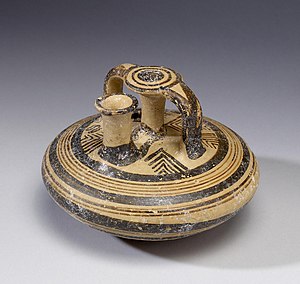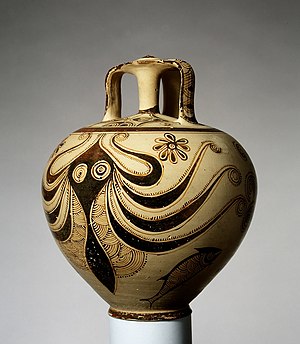| Stirrup jar | |
|---|---|
| Linear B ka-ra-re-we, probably krairēwes from κραῖρα, "head, extremity, protrusion".[1] | |
 Two examples of Mycenaean stirrup jars | |
 | |
| Material | Ceramic |
| Writing | About 10 instances of the LH/LM IIIB transport type have Linear B inscriptions. |
| Created | Late Bronze Age, with an origin in the late Middle Bronze Age |
| Discovered | Eastern Mediterranean, especially Crete and mainland Greece |
| Discovered by | Schliemann. |
| Classification | pouring vessel |
| Culture | Mycenaean Greece, Minoan Crete |
A stirrup jar is a type of pot associated with the culture of Mycenaean Greece. They have small squat bodies, a pouring spout, and a second nonfunctioning spout over which the handles connect like a stirrup. During the Late Bronze Age, they were used in the export of oils, and are found in large numbers at sites around the Eastern Mediterranean and beyond.[2] The term "stirrup-jar" is a translation of German "Bügelkanne", the name assigned to them by Heinrich Schliemann who found the first instances during his excavations at Troy.
- ^ Chadwick 1974, p. 328
- ^ Schliemann, Heinrich (1892). Schliemann, Sophie (ed.). Heinrich Schliemann's Selbstautobiographie (in German). Leipzig: F.A. Brockhaus. p. 97.